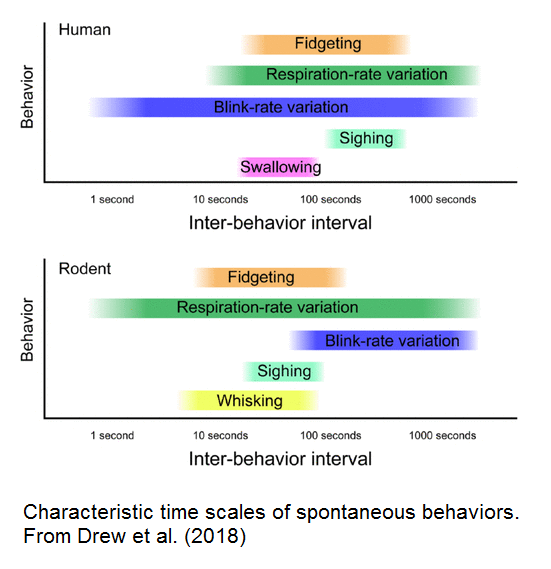The Fidgeting Brain
Posted on Categories Discover Magazine

A new review paper in The Neuroscientist highlights the problem of body movements for neuroscience, from blinks to fidgeting.
Authors Patrick J Drew and colleagues of Penn State discuss how many types of movements are associated with widespread brain activation, which can contaminate brain activity recordings. This is true, they say, of both humans and experimental animals such as rodents, e.g. with their ‘whisking’ movements of the whiskers.
A particular concern is that many movements occur (or change in frequency) over similar timescales to some measures of neural activity – especially resting state fMRI – which means that movement-related activity could be mistaken for more interesting neural signals.
Here’s how the authors describe the relationship between one kind of movement, blinking, and brain activity:
Blink-related modulations are visible in BOLD functional magnetic resonance imaging (fMRI) signals in the primary visual cortex, as well as higher brain regions, such as the frontal eye field (FEF), and regions associated with the default network and somatosensory areas… If the rate of blinking were constant, ongoing blinks would not be an issue, and they would simply be averaged out. However, spontaneous eye blink rate dynamically varies on slow time scales (~0.001 Hz to 0.1 Hz), and these variations can drive correlated activity in multiple brain regions.
Long-time readers may recall that I blogged about one blink-fMRI study back in 2012. In fact, none of the issues discussed by Drew et al. are new. The potential for movements to cause problems are well known to most neuroscientists, especially those working with fMRI. Yet this doesn’t mean the problems are fully solved.
In particular, Drew et al. point to fidgeting – small movements of the body – as an unsolved problem. Unlike movements of the head, which are relatively easy to detect (because the head is what neuroscientists are looking at), body movements are more difficult to measure. Yet bodily fidgeting happens all the time, and it can alter brain activity both in humans and animals:
Functional activation of motor and somatosensory areas will occur with any motion, and body motion is not monitored in most studies. Relatively small body motions are accompanied by robust motor cortex activation, which is clearly apparent in fMRI.
Worse, fidgeting isn’t always random: it can be associated with particular aspects of experiments:
Many sorts of tasks and stimuli (including ones that are not overly motor), are preceded, accompanied, and/or followed by muscle activation in both humans and animals. These muscle activations will generate proprioceptive and cutaneous feedback that will activate somatosensory areas, as well as in brain regions that receive input from the superior colliculus.
Drew et al. say that anaesthesia stops animals from fidgeting, but as it also eliminates normal brain activity, it’s not a good solution for most studies of brain function. Instead, the authors conclude, we need to find better ways to measure fidgeting:
As the rate and timing of fidget-like behaviors will be impacted by common experimental manipulations and pathologies, the solution is to monitor these behaviors, and either subtract out or censor their effects. We argue that detailed monitoring of these spontaneous behaviors is an import step in understanding brain dynamics during whole-brain neural or hemodynamic imaging.
The paper ends on a hopeful note, as the authors say that new technologies such as high-speed cameras, and methods developed by the fMRI community for correcting for head movement, could well offer a solution to the fidget menace.